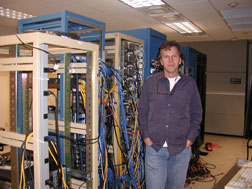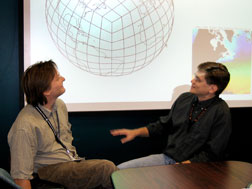NEWS RELEASES
FOR IMMEDIATE RELEASE
October 30, 2006
Sandia computational science projects funded by the DOE Office of Science
 SANDIA RESEARCHER ROB ARMSTRONG received funding to do "plug-and-play" supercomputing. (Photo
by Nancy Garcia)
SANDIA RESEARCHER ROB ARMSTRONG received funding to do "plug-and-play" supercomputing. (Photo
by Nancy Garcia)Download 300dpi JPEG image, “scidac-rob-armstrong.jpg,” 644K (Media are welcome to download/publish this image with related news stories.)
ALBUQUERQUE, N.M. — Eight Sandia National Laboratories computational science projects have been awarded a total of $2.9 million annually over the next five years by the Office of Advanced Scientific Computing Research (ASCR) within the DOE Office of Science. The announcement of the awards was made last month after a competitive, peer-reviewed proposal process.
The Office of Science’s “Scientific Discovery through Advanced Computing” (SciDAC) program is making the funding available to 30 projects, of which Sandia is involved in eight. Participating in the 30 projects are 70 institutional partners and hundreds of researchers and students. All of the projects involve several partners and large-scale collaborations.
The projects of which Sandia is a part all entail large-scale computer simulations aimed at accelerating research in a wide range of areas, including the design of new materials, developing future energy sources, studying global climate change, and understanding physics from the tiniest particles to the massive explosions of supernovae.
“Among the reasons the Sandia projects were awarded funding is our unique experience using high-performance computers,” says Scott Collis, point of contact for Sandia’s ASCR research. “Our ongoing work in both designing and using state-of-the-art supercomputers such as Red Storm and Thunderbird [computers] has provided us expertise in supercomputing that is respected around the country.”
He adds, “This expertise crosscuts Sandia sites in New Mexico and California, as does the SciDAC funding.”
Sandia is a National Nuclear Security Administration laboratory.
 SANDIA RESEARCHERS Mark Taylor, left, and Bill Spotz
will spend the next five years trying to figure out what the
future might hold for the Earth’s atmosphere by collaborating
on a large-scale computer model. (Photo
by Chris Burroughs)
SANDIA RESEARCHERS Mark Taylor, left, and Bill Spotz
will spend the next five years trying to figure out what the
future might hold for the Earth’s atmosphere by collaborating
on a large-scale computer model. (Photo
by Chris Burroughs)Download 300dpi JPEG image, “scidac-mark-taylor.jpg,” 620K (Media are welcome to download/publish this image with related news stories.)
SciDAC computational work will be done on new DOE petascale computers that are planned to go into operation at Oak Ridge and Argonne national laboratories by the end of the decade.
Petascale computing refers to petaflops, a million billion calculations per second, and petabytes, a million billion bytes of data. This level of computing power will enable researchers to study scientific problems at an unprecedented level of detail. For example, current models allow scientists to design materials with thousands of atoms, while petascale computing will allow models with millions of atoms, yielding more accurate simulations that will promote fundamental scientific discovery.
Sandia projects awarded SciDAC funding include:
- Center for Interoperable Technologies for Advanced Petascale Simulations (ITAPS). Sandia’s principal investigator is Pat Knupp. The goal of this center is to deliver interoperable and interchangeable mesh, geometry, and field services that are of direct use to science applications, including accelerator modeling and design, fusion energy science, groundwater reactive transport modeling and simulation, and nuclear energy. The lead institution is Lawrence Livermore National Laboratory.
- Center for Technology for Advanced Scientific Component Software (TASCS). Sandia’s principal investigator is Rob Armstrong. This project will make possible software and programming language interoperability so that simulations can be turned on and off as needed. The lead institution is Oak Ridge National Laboratory.
- Towards Optimal Petascale Simulations (TOPS). Sandia’s principal investigator is Mike Heroux. The heart of many scientific applications is known as the “solver,” which is responsible for simultaneously solving large numbers of coupled linear equations. Unfortunately, the solver is often the chief bottleneck in utilizing supercomputers, and the TOPS center is focused on developing new solver algorithms that break this barrier, thereby enabling effective use of petascale computers. The lead institution is Columbia University.
- Combinatorial Scientific Computing and Petascale Simulations (CSCAPES). Sandia’s principal investigator is Erik Boman. This institute will accelerate the development and deployment of fundamental enabling technologies in high-performance computing by providing advanced new capabilities in load balancing and parallelization toolkits for petascale computers, and advancing the state of the art in software tools that will enable larger and faster simulations. The institute will also organize workshops, host visitors, and reach out to the academic community. The lead institution is Old Dominion University.
- Petascale Data Storage Institute. Sandia’s principal investigator is Lee Ward. This project will educate the scientific computing community on best practices for efficiently using large-scale storage systems on petascale computers. To reach out and engage the scientific computing community in petascale storage, the institute will chair an annual petascale storage workshop in conjunction with a major scientific computing conference. The lead institution for the project is Carnegie Mellon University.
- SciDAC Institute for Ultrascale Visualization. Sandia’s principal investigator is Ken Moreland. Understanding the science behind ultra-scale simulations and high-throughput experiments requires scientists to understand information coming from massive datasets. This institute will put together a comprehensive parallel visualization suite that can move across computing platforms to allow scientific discovery at large scales. The lead institution is University of California, Davis.
- Modeling the Earth’s Climate System. Sandia’s principal investigator is Mark Taylor. The goal of this project is to predict future climates based on scenarios modeled on a petascale computer. The lead institution in this research effort is Oak Ridge National Laboratory.
- Chemistry Framework using Common Component Architecture. Sandia’s principal investigator is Curt Janssen. The development of emerging technologies such as molecular computing, nanotechnology, and next-generation catalysts will continue to place increasing demands on chemical simulation software, requiring more capabilities and more sophisticated simulations. This project will enable development of such software by providing common interfaces and infrastructure that permit the capabilities from multiple quantum chemistry codes to be easily employed in new applications. This will allow development of novel modeling approaches that can run efficiently on large-scale parallel machines. The lead institution for the project is Ames Laboratory.
Collis says an important aspect of these projects is that they will allow Sandia to develop even more collaborations in the high-computing world, both in the DOE laboratory complex and throughout academia.
“We’ll gain additional experience and capability in using supercomputers that will have impact far beyond the individual SciDAC projects,” he says. “At the same time, we will be able to pursue cutting-edge collaborative science in a wide range of areas. And the most exciting aspect of this funding is that it will result in new discoveries that we can’t yet predict.”
See, “Sandians to spend next five years figuring out the future of the Earth’s atmosphere through modeling.”
Sandia is a multiprogram laboratory operated by Sandia Corporation, a Lockheed Martin company, for the U.S. Department of Energy’s National Nuclear Security Administration. Sandia has major R&D responsibilities in national security, energy and environmental technologies, and economic competitiveness.
Sandia news media contact: Chris Burroughs, coburro@sandia.gov, (505) 844-0948